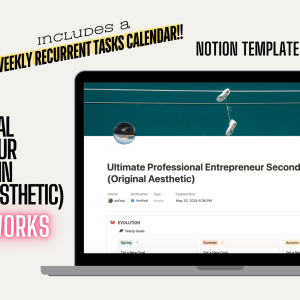Create and Sell Digital Products Online: A Beginner’s Guide

There are many opportunities to create and sell digital products online now. In fact, there are so many that choosing what to do at the beginning can be daunting. Whether you want to share your expertise, monetize a hobby, or build a full-fledged online business, digital products offer a scalable and flexible way to generate income. But how can we best do it when we don’t know how? Keep reading.
Sell Digital Products Online… Which ones?
Digital products are perfect because they usually entail very low production costs. They are intangible goods that can be created, distributed, and consumed electronically. You can even turn a “physical product” into a digital one when you teach others about it.
- E-books: These are great for having monthly residuals, but the monthly income might not be huge. Let’s be honest: breaking it on Amazon as an indie writer is hard unless you write steamy romance. Writing a book is hard, and it can take months to find something nice. (Read that again: AI to edit you can use, but writing everything with AI is not a good idea!) You can get some ideas from Write Your First Book Draft Effortlessly (For Super Busy Parents with a 9 to 5).
- Online Courses: Educational content like the one you can find here or through my Gumroad page is also great. Creating a good course can take months, too! However, the rewards are plenty. You can share your take on a topic and also create a community around it.
- Printables and Templates: Think about Canva template bundles and printables. These are also great companions for other digital goods, like ebooks and courses.
- Graphics and Digital Art: Design assets, stock photos, or illustrations. Although I use DALL-E here for banners, I hired an illustrator to cover one of my books. You can also use your digital art to create courses and teach others how to draw like you.
These are just some examples of what you can do. However, remember that a good digital product is one in which you’ve invested many hours to achieve a nice result. If you’re happy with the result and you use it, then it’s very likely that you’ll find online customers for your digital products.
Identify Your Niche and Target Audience
The first step in creating digital products is identifying your niche and target audience. This involves understanding who your potential customers are and what problems or needs they have. Sometimes, you love doing something and sharing it, but there’s a very small market for that. In that case, it’s not a good idea to invest your time in selling that product online.
- Self-Assessment: Consider your skills, interests, and expertise. What unique value can you offer?
- Market Research: Use tools like Google Trends, social media, and forums to explore trending topics and common pain points in your niche.
- Audience Persona: Create a detailed profile of your ideal customer, including demographics, interests, and buying behavior.
Validate Your Product Idea
Before investing time and resources into creating a digital product, validating your idea is important to ensure there is demand. You might find that your audience persona might like it, but it can turn out that they won’t pay for it! You can do:
- Surveys and Polls: Ask your audience directly through surveys or polls to gauge their interest in your product idea.
- Competitor Analysis: Look at similar products in your niche. Analyze their features, pricing, and customer feedback.
- Pre-Sales: Offer a pre-sale or crowdfunding campaign to test the market and gather funds for development.
Create Your Digital Product (the Fun Part!)
Once you’ve validated your idea, it’s time to create your digital product. The creation process will vary depending on the type of product. However, good digital products need time!
- Planning: Outline the structure and content of your product. For example, plan the modules and lessons if you’re creating an online course.
- Content Creation: Produce the content using appropriate tools. This might involve writing, recording videos, designing graphics, or coding.
- Editing and Polishing: Review and refine your content to ensure it’s high quality and error-free.
- Format and Package: Convert your content into a suitable format (e.g., PDF for e-books, MP4 for videos) and package it for delivery.
If you need some guidance, you can get ideas from Create Your Tarot Deck with the Help of AI (if you like the Tarot, of course). You can even create a digital magazine using Notion! Check out the Create a Magazine in Notion & Monetize it course.
Set Up Your Online Store
This one can be super easy if you use third-party platforms or difficult if you create your own platform like me. Just take a look at dePepi! It looks gorgeous. (I’m very proud of it!) But it took me a while to have something I loved.
- E-commerce Platforms: Platforms like Shopify, WooCommerce, and BigCommerce allow you to create a custom online store.
- Marketplaces: Sites like Etsy, Gumroad, and Amazon Kindle Direct Publishing provide ready-made marketplaces for selling digital products. (I use Gumroad and Amazon KDP!)
- Course Platforms: For online courses, consider platforms like Teachable, Thinkific, and Udemy. For teaching, I use Notion and this platform. I know Notion is not for courses, but it looks great and is super easy to set up. Once you’ve created your course in Notion, you’ll need a platform to showcase it: Gumroad. Take a look here!
- Direct Sales: You can also sell directly through your website using payment processors like PayPal or Stripe. Create your own platform using WordPress and control every single aspect of it. It might take a while to set it up, but you can have great results with it!
Tough Decision: Give Your Products a Price!
Pricing is crucial in selling digital products, but deciding the number can be difficult.
- Cost-Based Pricing: Calculate your production costs and add a margin to determine your price. However, since you’re selling digital goods, sometimes it’s better to count how many hours you spent on creating your product to make the calculation instead.
- Value-Based Pricing: Price your product based on the perceived value to the customer. Consider the benefits and results your product delivers.
- Competitive Pricing: Analyze the prices of similar products in your niche and price accordingly.
- Tiered Pricing: Offer different pricing tiers or packages to cater to different customer needs and budgets. You can get an idea with AI Mixer here.
Marketing and Promotion
Marketing is essential to reach your target audience and drive sales. Writing a blog with useful information like this one is the best idea. Why? Because you’re giving away practical information that your audience can use, and then they can decide if they want to purchase something from you.
- Content Marketing: Create valuable content (blogs, videos, podcasts) that attracts and engages your audience.
- Social Media: Use platforms like Instagram, Facebook, Twitter, and LinkedIn to promote your products and interact with your audience. If you need a social media content planner, please check mine here.
- Email Marketing: Build an email list and send regular newsletters and promotions to your subscribers. The best platform for that is Substack. (I just love it! You can even send a podcast as a newsletter!)
- Influencer Partnerships: Collaborate with influencers in your niche to reach a larger audience.
- Paid Advertising: Invest in ads on platforms like Google Ads, Facebook Ads, or Pinterest Ads to drive traffic to your store. This is my least favorite option because it can be tricky! You need to research which platform will work for you best and create a campaign that you know will resonate with your audience. Don’t just “try” for the sake of trying!
Manage Sales and Customer Support
And if your plan to sell products online works, you’ll need to manage sales and have a top-notch customer support system in place. Here are some tips:
- Automated Delivery: Set up automated delivery for digital products so customers receive their purchases instantly. This works like a charm with Gumroad. But if you want to create a system like mine, there are ways to automate everything.
- Customer Service: Offer timely and helpful support through email, live chat, or social media. If you don’t have much time to dedicate to it, let your customers know how many days they’ll need to wait for your answer. Be reasonable! Don’t make people wait for 10 days!
- Feedback and Reviews: Encourage customers to leave reviews and use their feedback to improve your products and services.
- Refunds: Have a clear refund policy in place and handle things professionally. Usually, digital products have no refunds. Once customers have access to them, that’s it! However, you’ll find out that you might have chargebacks! Unfortunately, there’s fraud online, and some customers you’ll have might not be legit. You’ll need to return the money to the right owners. Other times, customers get the goodies, and they still go for them because they might forget to make the purchase after a while. If you’re using Stripe, take time to read all about refunds and what chargebacks are.
Time to Grow Your Business!
If you notice that your product sells well, why not create another one? The more digital products you have, the easier it will be for you to create bundles and offers.
- Expanding Product Line: Create additional products that complement your existing offerings.
- Bundling: Offer product bundles or packages at a discounted rate.
- Upselling and Cross-Selling: Promote higher-end products or related items to existing customers.
- Affiliate Programs: Start an affiliate program to incentivize others to promote your products. Please subscribe here if you want to earn 30% of all sales on paid Gumroad dePepi products. That’s a very generous offer! Usually, affiliates pay way less.
Improvement and Learning
If you want to learn how to set up your online business successfully, you can enroll in my course here. I share with you all I know about how to make your dream come true! And, if you want access to all the courses on dePepi (and the ones in Gumroad) and all personal templates, please consider becoming a founding member here.





